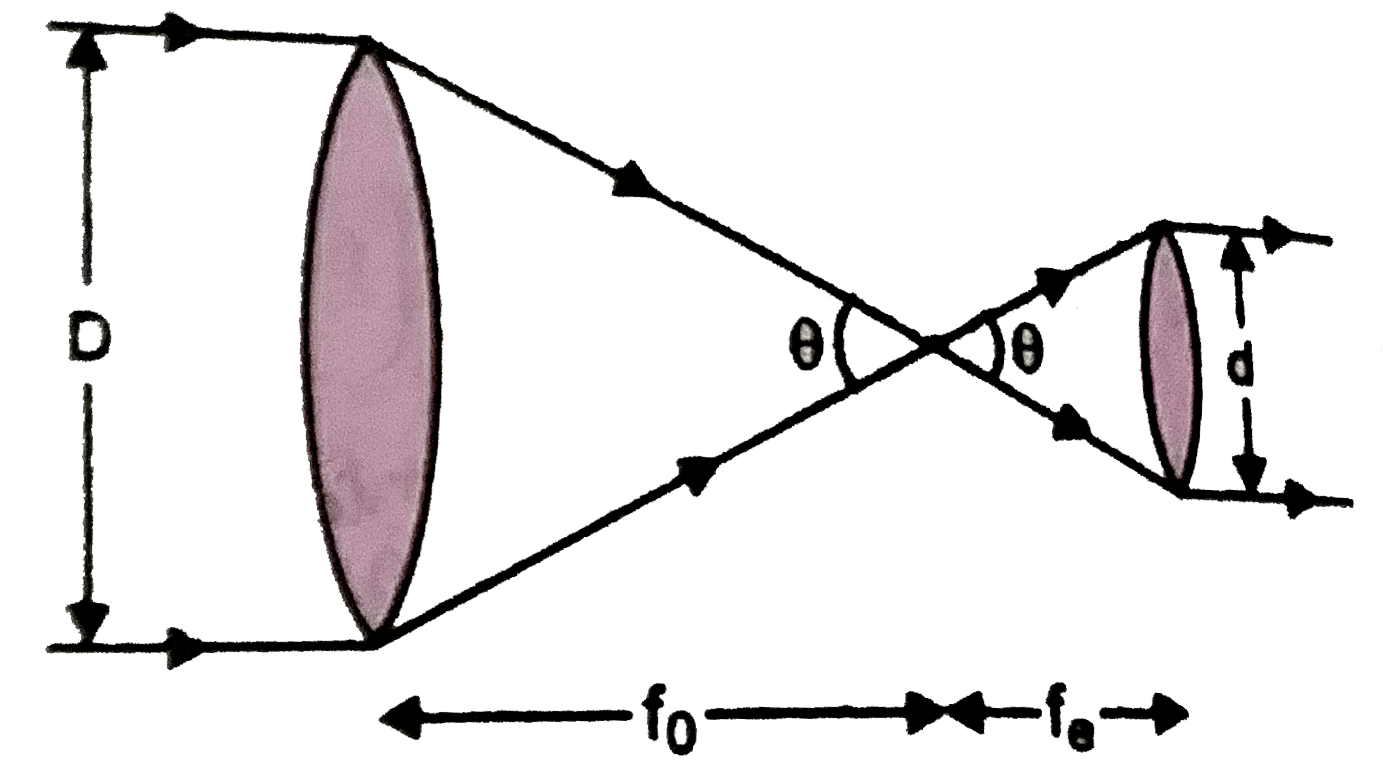The angular magnification of a telescope is 300 What should be the diameter of the objective, if our eyes at the eye ring, are just able to collect all the light refracted from the objective. Take diameter of pupil of eye =3mm.
The correct Answer is:90 mm
Here m=300,D=?,d=3mm=0.3cm.
m=f0fe=D/θd/θ=Dd
∴D=m×d=300×0.3=90cm.
 .
.
Topper's Solved these Questions
- RAY OPTICSBOOK - PRADEEPCHAPTER - RAY OPTICSEXERCISE - (Test Your Grip)Multiple Choice (b)
10 Videos
- RAY OPTICSBOOK - PRADEEPCHAPTER - RAY OPTICSEXERCISE - (Test Your Grip)Multiple Choice (c)
10 Videos
- RAY OPTICSBOOK - PRADEEPCHAPTER - RAY OPTICSEXERCISE - Problem For Practice(c)
27 Videos
- PROPERTIES OF BULK MATTERBOOK - PRADEEPCHAPTER - PROPERTIES OF BULK MATTEREXERCISE - Multiple choice questions
7 Videos
- SYSTEMS OF PARTICLES AND ROTATIONAL MOTIONBOOK - PRADEEPCHAPTER - SYSTEMS OF PARTICLES AND ROTATIONAL MOTIONEXERCISE - Assertion- Reason Type questions
20 Videos
Similar Questions
Knowledge Check
Assertion : The resolving power of a telescope is more if the diameter of the objective lens is more.
Reason : Objective lens of large diameter collects more light.AIf both Assertion & Reason are True & Reason is a correct explanation of the Assertion.BIf both Assertion & Reason are True but Reason is not a correct explanation of the Assertion.CIf Assertion is True but the Reason is False.DIf both Assertion & Reason are False.Angular magnification of telescope if focal length of objective and eye lenses are 10 cm and 10 mm respectively and tube length is 11cm:
A10B5C100D50A : When viewing through a compound microscope, our eyes should be positioned not on the eye piece but a short distance away from it for best viewing.
R : The image of the objective in the eye-piece is known as 'eye-ring' and if we position our eyes on the 'eye-ring' and the area of the pupil of out eye is greater or equal to the area of the eye ring, our eyes will collect all the light refracted by the objective.AIf both Assertion & Reason are true and the reason is the correct explanation of the assertion, then mark (1).BIf both Assertion & Reason are true but the reason is not the correct explanation of the assertion, then mark (2).CIf Assertion is true statement but Reason is false, then mark (3).DIf both Assertion and Reason are false statements, then mark (4).
At what magnification T of a telescope with a diameter of the objective D=6.0cm is the illuminance of the image of an object on the retina not less than without the telescope ? The pupil diameter is assumed do be equal to d0=3.0mm. The losses of light in the telescope are negligible.
View SolutionAn astronomical telescope has an angular magnification of magnitude 5 for distant objects. The separation between the objective and an eye piece is cm and the final image is formed at infinity. Calculate the focal length of the objective and the focal length of the eye piece?
View SolutionHuman eye is sensitive to light of wavelength 5,500Å. Calculate the limit resolution of eye if diameter of pupil in the eye is nearly 2 mm.
View SolutionEstimate the limit of resolution of a human eye, for the light of wavelength 500 nm. (Take diameter of human eye equal to 2 mm).
View SolutionWhen a telescope is adjusted for parallel light, the distance of the objective from the eye piece is found to be 80cm. The magnifying power of the telescope is 19 . The focal length of the lenses are
View Solution
